For tiny yards with little area, small trees are ideal. Trees in a small yard offer more than just aesthetic value. Shade, privacy, colorful flowers, wildlife attraction, and abundant fruit are all benefits of many kinds of tiny trees. Several tree species are cultivated to be modest in size and avoid growing excessively. Crabapple, red buckeye, gray birch, and cockspur hawthorn are examples of small trees that may be used for landscaping a yard.
In what kind of landscape garden should small trees be used? Little evergreen trees seldom grow more than 6 feet tall. Dwarf cultivars of other tree species may appear to be the actual tree, although they are only a few feet tall. Moreover, several little tree species have a spreading tendency and may be trimmed to control their height.
There is a kind of modest tree that is ideal for you whether you have a little yard, front yard, or tiny garden. If you don’t have a lot of yard space, read on to learn which kind of small and dwarf trees might be appropriate for your needs.
Small Trees for Landscaping Small Spaces
It is important to consider a variety of factors when planning types of trees for a small landscaped yard. You should know how much space you have before you choose the proper low-growing tree for your front or backyard. As a result, it’s a good idea to estimate how big the tree will become and its reach.
Also, check whether the little tree thrives in your zone and how much sunlight it requires. The proximity to your home that you may plant the tree will also be determined by the tree’s height. The distance of the tree from your home should be at least one-half its height, according to a rough rule of thumb. Plant your tree at least 10 feet (3 meters) away from the structure if it will grow to be 20 feet (6 meters).
It’s also a good idea to keep in mind that since they’re slow-growing, some ornamental trees are ideal for small-scale yards. Little weeping trees, tiny cypress trees, and small fruit trees are some more excellent options when yard space is restricted, in addition to dwarf evergreens.
For landscaping purposes, what is considered a small tree? A small type of tree is defined as one that does not grow taller than 25 feet (7.6 meters). You may have to search for smaller cultivars or dwarf specimens if your yard is small.
Small Trees for Backyard

When picking suitable sizes of trees for a small yard, both privacy and shade are necessary factors to consider. Japanese maples, crape myrtle trees, tiny magnolias, and dwarf junipers are all low-maintenance small trees that work well. In a small garden, certain types of fir trees make excellent privacy hedges. Their leaves are gentle and thick, and they don’t need a lot of care.
Small Trees for Front Yard
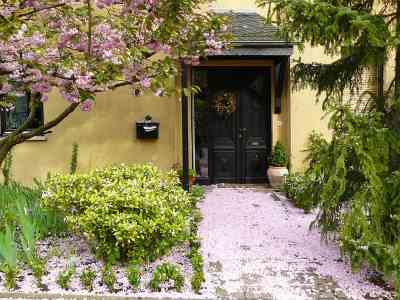
Small cultivars of redbuds, crabapples, dogwoods, and magnolias are among the most popular small trees for the front yard because they provide both ornamental and decorative value. These blossoming trees will have a beautiful impact on the appearance of your home in a small front yard.
Dwarf Trees vs. Small Trees for Landscaping – Which One is the Best Option?
You can choose between tiny trees and dwarf trees when it comes to landscaping a modest garden. Several varieties of dwarf trees are stunning decorative examples with unusual forms and colors. Choosing a dwarf tree allows you to know how big it will grow.
Dwarf cultivars are typically 8 to 10 feet (2.4 to 3 meters) high. You might also search for little miniature trees depending on how big your yard is. Some cultivars may only reach a height of 6 to 8 feet (1.8 to 2.4 meters). Adding a little bit of aesthetic to your front or backyard with a few small trees can help.
The Best Trees for Small Front Yard or Small Back Yard (With Pictures)
In a small-scale yard or garden, what are the greatest little trees to plant? If your property is limited, here are some of the greatest landscaping trees to pick from. Several dwarf flowering tree types may be found at the bottom of this list.
Small Trees for Landscaping (With Pictures For Easy Identification)
Gray Birch (Betula populifolia)
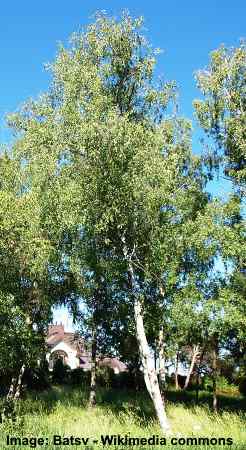
The gray birch is a tiny, narrow tree that makes a excellent small landscape tree for tiny yards. Gray birches have white-gray bark and grow up to 20 feet (6 meters) tall. The leaves of this kind of tree are bright green, oval in shape, and have an extended tip.
The leaves reach a length of 2.7 (7 cm) and a width of 2.3 (6 cm). The gray birch has a tall, thin growth habit that causes it to provide little shelter in the garden. If you have a lot of plants or don’t want to obstruct sunlight in your home, this is a good option.
Zone 3 to 6 birch trees thrive in full sun and partial shade, and they can tolerate a wide range of soils. Check out the Betula utilis ‘Long Trunk’ Tree if a 20-foot (6-meter) birch tree is too tall for your backyard. It takes 20 years to grow 16 feet (5 meters) tall with this small weeping birch cultivar.
Cockspur Hawthorn (Crataegus Crus-Galli)

The cockspur hawthorn is a small landscape tree that requires little care. This small flowering tree has a wide spread and rounded form that grows to about 25 feet (7.6 meters) tall. In the spring, white blooms give way to crimson berry fruits. The leaves turn a brilliant display of red or purple foliage when they change color in the autumn.
This is a miniature tree that requires little pruning and has minimal care. If you want to keep its height low, you can trim it regularly. In zones 4 through 7, these little landscape hawthorn trees flourish and provide color for most of the year. They have a spread of up to 35 feet (10.5 meters), so you should plant them in full sun.
Eastern Redbud (Cercis canadensis)

The eastern redbud is a compact flowering tree that doesn’t grow too tall (lower picture) if space is tight in your yard. Eastern redbuds have white or pink blooms that bloom in the spring, which is a distinguishing characteristic. For gardens with limited space, the Cercis canadensis ‘Ace of Hearts’ is a great option.
The tree has nine to twelve stems that are up to 9 feet (2.7 m) tall when fully grown. As a result, the tree develops numerous small trunks that resemble those of a huge flowering shrub. In the fall, the dark green leaves turn yellow. This landscaping tree thrives in full sun to part shade and grows in zones 5 through 9.
Red Buckeye (Aesculus pavia)

Aesculus pavia ‘Splendens’ is a lovely small tree that may be found for sale as shown in the photograph. The crimson buckeye is a gorgeous specimen tree when yard space is limited, and it’s also known as the crimson horse chestnut tree. For modest yards, this can also be utilized as a privacy tree.
The canopy of dense dark green leaves produced by red buckeye trees grows to between 12 and 15 feet (3.6 and 4.5 meters) tall. Mid- to late-spring brings a burst of vibrant colors with crimson flowers. These landscaping trees have a bushy appearance and are slow-growing, which is one of their advantages. These small trees need full sun and moist but well-drained soil to thrive in zone 5 – 9 for a front or back yard.
Kousa Dogwood (Cornus kousa var. chinensis)

During the summer (as seen in the picture), the kousa dogwood is a flowering tiny tree with scarlet berries. Dogwood blooms are lovely regardless of species. During the spring, this tiny tree produces stunning star-shaped pink and white blooms. The tree is covered in crimson berries during the summer, and its wide canopy of huge oval, pointed leaves provides shaded areas around the yard.
When the leaves change color in the fall, you get lovely hues of purple and scarlet-red to enjoy. In comparison to its cousin the Cornus florida, the kousa dogwood is a sturdier and more disease-resistant landscape tree. This has a medium growth rate and requires little care, as do many of the finest small landscape trees. This small bright tree thrives in partial to full sun and thrives in zones 5 through 8.
Small Witch Hazel Trees (Hamamelis)

Depending on their growth, witch hazels may be classified as little trees or big shrubs. In cold climates, these little trees are the finest choice for tiny gardens. The vibrant foliage of witch hazel trees adds to the landscape’s beauty. Many witch hazel trees have a small height, making them perfect for when space is constrained. In the spring, the tree has lovely green leaves that turn yellowish-orange in the autumn.
With their scented yellow blooms with thin spindly petals, witch hazels brighten withered gardens throughout winter. Witch hazels come in a variety of colors and sizes, ranging from 15 to 20 feet (4.5 to 6 meters) in height and width. They thrives in full sun and partial shade and grows well in zones 3 to 8. Privacy hedges, specimen plants, and shrub borders are some other uses for them.
Weeping Cherry (Prunus ‘Snow Fountain’)
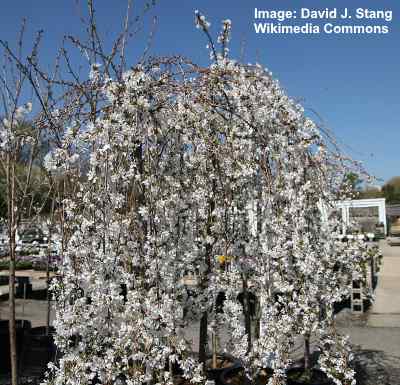
The weeping cherry is one of the greatest weeping landscape plants for small gardens and yards, with its lovely white blooms. This tiny tree reaches a height of 8 to 15 feet (2.4 to 4.5 meters). It resembles a dwarf in size. The fact that this tiny cheerful blossom produces an cascade of beautiful tiny white flowers is the reason it is a popular pick for modest front yards. The delicate white blooms cascade down the branches.
Dark green ovate-shaped leaves develop rich foliage throughout the summer, before fading to orange and yellow in the autumn. The weeping cherry is a slow-growing tree with weeping branches and a low height that makes it one of the best landscaping trees. In the middle of a front or backyard, dwarf weeping cherry trees may be employed as beautiful landscape specimens. In USDA zones 5 – 8, they need full sun to thrive.
Magnolias

Most magnolia species are good for tiny gardens, adding beauty, summer scents, and nice green leaves. Magnolia varieties with shorter leaves reach lengths of 10 to 15 feet. They are noted for their beautiful blooms and grow to be tall (3–5 m). In the early or mid-spratg of the year, magnolias bloom and each blossom is exquisite. Star-shaped, saucer-shaped, bowl-shaped, and tulip-shaped flowers may be seen on little magnolia trees.
Pink, white, yellow, magenta, or cream-colored blossoms are possible. Some types produce gorgeous, fragrant blossoms that are a showstopper. To landscape your garden, check out tiny examples of magnolias. Magnolia trees, such as Magnolia ‘Ann,’ ‘Black Tulip,’ and so on, are ideal for landscaping in zones 5 through 9.
Crabapple Trees (Malus)
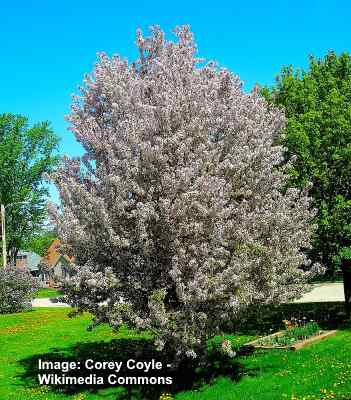
Plant tiny trees like dwarf crabapple trees if you have a small area. Dwarf apple trees and crabapples may reach a height of around 10 feet (3 meters) when nonstandard apple trees may reach 30 feet (9 meters). They are tall (3 meters) and slender. Crabapples aren’t just a bumper crop in the fall, but they also produce lovely white blossoms in the spring. Planting them in your small landscaped yard is a win-win situation. If you want a short crabapple tree, look for the Malus x robusta ‘Red Sentinel.’
In most seasons, the flowering fruit tree provides a wealth of garden color. Your spring garden is highlighted by white flowers. After that, the tree will be covered in bright red tiny apples all winter. If you want bigger apples, choose a variety of semi-dwarf or dwarf apple trees. Apple trees thrive in zones 4 through 8, and they need moist, well-drained soil with plenty of sun to thrive.
Persian Ironwood (Parrotia persica ‘Vanessa’)

The Persian ironwood is a slow-growing tree with gorgeous leaves in the fall. One of the nicest winter tree landscapes is a slow-growing, low-maintenance tree. The gorgeous oval-shaped leaves of the exotic Persian ironwood create a dense canopy. Throughout the summer, the leaves become deep green and are bronze or burgundy in color.
The leaves turn bright gold, bronze, orange, and crimson colors in the autumn. In the winter, spectacular spidery crimson blooms contrast with the gray bark. Persian ironwoods flourish in zones 6 through 9 and grow to between 15 and 40 feet (4.5–12 m) tall.
Dwarf Flowering Trees to Plant in Small Yards (With Pictures For Easy Identification)
Choosing from one of several dwarf flowering tree types may give impact to a tiny garden without taking up too much area if your yard is tight on area. If you want to have flowering dwarf trees on your porch or balcony, they can be grown in containers.
Dwarf Pear Trees (Pyrus communis)
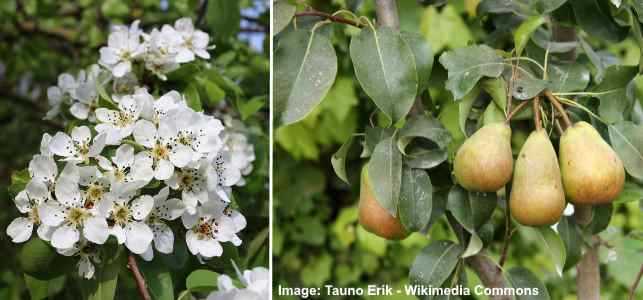
In tiny back or front yards, dwarf pear trees may provide lovely blooms and fruits. Dwarf pear tree varieties may achieve a height of 8 to 10 feet. They’re tall (2–3 meters) and produce full-sized pears later in the season. They bloom in the spring and early summer. In the fall, these dwarf flowering fruit trees offer crimson and yellow foliage. As a specimen tree or part of a shrub border, plant it.
Japanese maples (Acer palmatum)
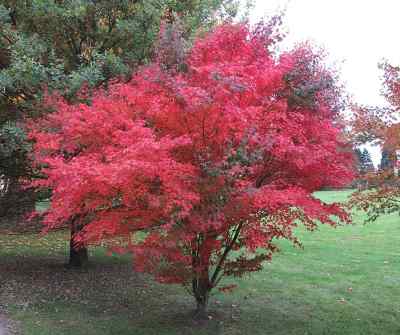
A dwarf Japanese maple tree is a standout amongst tight landscaped gardens for its bright hues. A weeping Japanese dwarf maple would make a terrific focal point if you want to make one. The cultivar ‘Red Dragon’ is the finest landscape example for tiny gardens.
The leaves of this Japanese maple tree turn scarlet red as they mature. It’s a 6-foot-tall (1.8-meter) slow-growing tree with cascading branches. The tree’s stunning hues make up for its lack of blossoms, despite the fact that its blooms are hidden.
Amelanchier ‘La Paloma’ (Serviceberry)
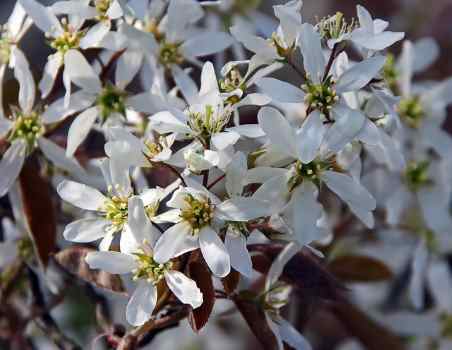
The serviceberry tree, also known as the white flowering dwarf, adds beauty to compact gardens with its tiny blooms. The slender stem and rounded leaves of this lovely tree add to its charm. With its fragrant white blooms and edible berries, this dwarf landscape tree attracts pollinators and birds. This little decorative tree, which grows to be about 8 feet (2.4 meters) tall, is ideal for flower beds and tiny areas.
Hydrangea ‘Grandiflora’ (Small Tree)
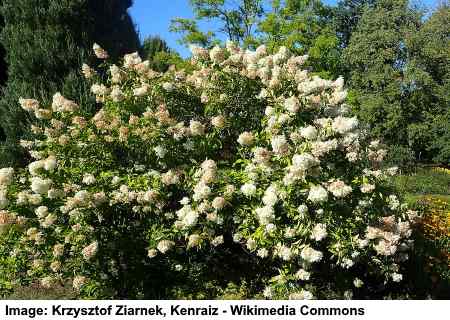
Hydrangeas may be classified as a dwarf flowering tree, especially when their huge showy blooms are viewed in limited area. Hydrangeas’ spectacular flower heads make them stand out in a small environment. Throughout the summer, the Grandiflora develops into a tiny multi-trunked tree with many blooms. Hydrangea landscaping trees range from 10 to 25 feet tall. Up to 7.5 meters tall (3 – 7.5 m)
Small Evergreen Trees
Little-scale landscaping may be aided by adding little and dwarf conifer types such as spruce, pine, and fir trees. For your tiny garden or pot, what are some of the best dwarf evergreens? To think about, here are a few:
- Blues Weeping Colorado Spruce. It grows to be around 10 feet tall. The silver-blue leaves owe their height to the fact that they are needle leaves.
- Dwarf Japanese Black Pine. This Asian dwarf evergreen pine tree will give your small garden a tropical appearance. After ten years, it will only be 4 feet (1.2 meters) tall.
- Dwarf Pencil Point Juniper. This juniper’s tall, slender growth makes it an ideal evergreen for achieving height in restricted areas.
- Dwarf Balsam Fir. A fast-growing, conical evergreen tree with thick green leaves that grows in a pyramidal shape. Little yards, balconies, patios, and in containers: choose landscaping that’s beautiful.
